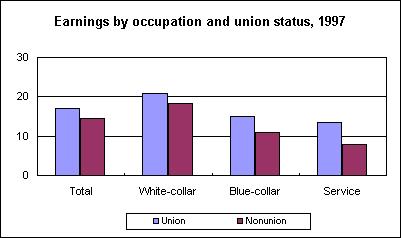April 25, 2000 (The Editor’s Desk is updated each business day.)
Union-nonunion wage gap narrows
Employment Cost
Index (ECI) data show that union pay consistently rose more rapidly than
nonunion pay between 1975 and 1982. In contrast, between December 1982 and
March 1999, nonunion pay has generally risen faster.

[Chart data—TXT]
Although union wages have not risen as rapidly as nonunion wages in
recent years, they are still higher. Data for March 1999 from the Employer
Costs for Employee Compensation program show that wages and salaries for
union workers in the private sector averages $16.21 per hour compared to
$13.54 for nonunion workers.
Moreover, data from the 1997 National Compensation Survey show that
union workers enjoyed a salary advantage over nonunion in almost all
occupations.
These data are a product of the National
Compensation Survey. Differences in
wages between union and nonunion workers may reflect factors other than
union representation. Among the factors are the specific mix of
occupational categories, the mix of full- and part-time workers, the size
and specific industry of the employer, and the establishment’s
geographic location. Find out more in Ann C. Foster, "Union-nonunion
Wage Differences, 1997" (PDF
61K), Compensation and Working Conditions,
Spring 2000.
Of interest
Follow BLS on Twitter
Get links to the latest BLS news releases on the BLS Twitter feed.
|
